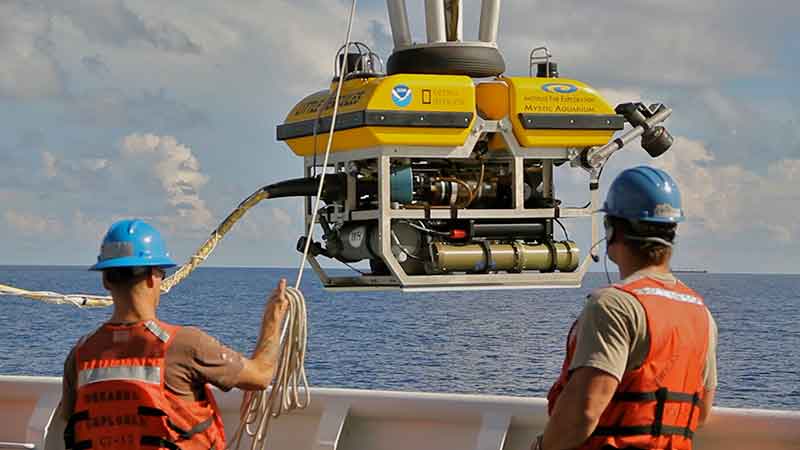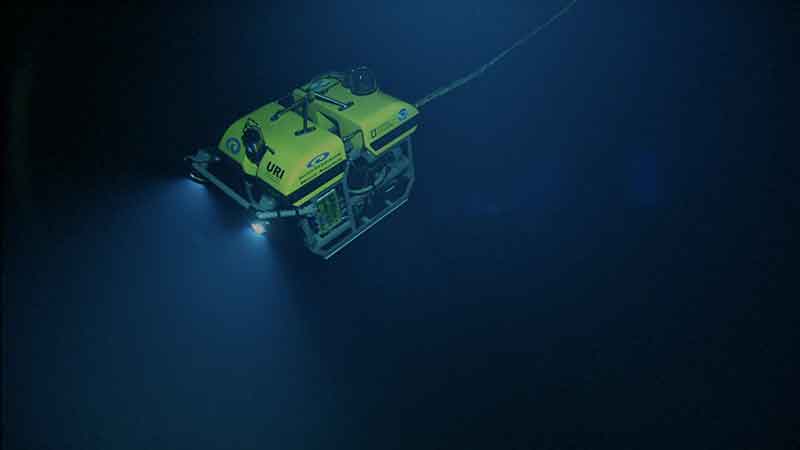
by Dave Lovalvo, ROV Operations Coordinator, NOAA Office of Ocean Exploration and Research
Video footage of the Little Hercules ROV being launched from NOAA Ship Okeanos Explorer. Video courtesy of the NOAA Office of Ocean Exploration and Research. Download larger version (mp4, 118.7 MB).
Little Hercules is a 4,000-meter depth rated remotely operated vehicle (ROV) with an impressive past and most promising future. “Little Herc”, as he is widely referred to, is just that – “little”. But as we all know, many good things come in small packages.
Little Herc came to the Okeanos Explorer through collaboration between the NOAA Office of Ocean Exploration and Research and Dr. Robert Ballard’s Institute for Exploration (IFE) at the University of Rhode Island (URI). With a major commitment to explore the waters off Indonesia, our program’s much larger ROV could not be readied in time for our 2010 sailing date. As a result, Little Herc was chosen as our stand-in.

IFE Little Hercules ROV at the University of New Hampshire during tank testing. Image courtesy of the NOAA Office of Ocean Exploration and Research, INDEX-SATAL 2010. Download larger version (jpg, 1.1 MB).
Originally developed by a team of engineers at IFE, Little Herc first came into the spotlight when he gave the world the first and only images of John Kennedy’s PT Boat, PT-109. After several other successful missions for IFE, Little Herc stepped down, taking a back seat to the now much larger and spectacular, “Hercules.”
After doing a short stint as an exhibit piece in the Mystic Aquarium, a proposal by the NOAA Office of Ocean Exploration and Research has given new life to the veteran “explorer.” Through a Joint Project Agreement between NOAA, IFE, and URI, a team of engineers from several institutions and companies once again went to work, this time recommissioning Little Herc. In a field where technology advances rapidly, it was necessary and appropriate that Little Herc receive a substantial upgrade before joining the ship.

The Okeanos Explorer crew launches the vehicle during test dives off Hawaii. Image courtesy of the NOAA Office of Ocean Exploration and Research, INDEX-SATAL 2010. Download larger version (jpg, 1.5 MB).
After an extensive four-month overhaul, Little Herc boasted a new motor controller and power bottle system, an upgraded fiber optic multiplexer system, a new Ultra Short Baseline Tracking System (USBL), a full-color imaging sonar, a new Conductivity-Temperature-Depth (CTD) sensor, two new single chip color CCD cameras, two new LED lights, two 400-watt HMI lights, and a spectacular high-definition video camera. New tethers, new tether terminations, a new transformer, a new electrical junction box, new depth and altitude sensors, a new light bar, and a new version of control software to make it all work was in order.
Tested at the University of New Hampshire’s Center for Coastal and Ocean Mapping prior to arrival in Hawaii for field trails, Little Herc has now come full circle. Today, the beautiful images you are seeing are once again Little Herc’s major contribution. Made possible by the generous support of our partners and engineers, Little Herc is back – diving deeper, shining brighter, and taking higher-resolution imagery than ever before! And my thanks to everyone.

Little Hercules during one of his first dives in Indonesia. A number of organizations and people were critical to bringing him back. Image courtesy of the NOAA Office of Ocean Exploration and Research, INDEX-SATAL 2010. Download larger version (jpg, 647 KB).